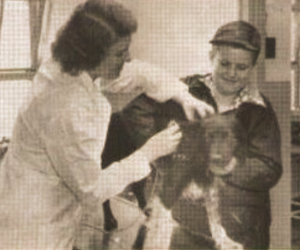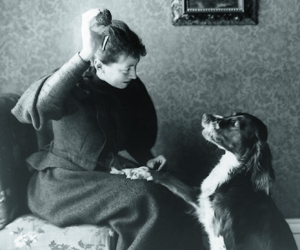Women of Anti-Cruelty

Dr. Jo-Anne Schmidt
Dr. Jo-Anne Schmidt was hired by Anti-Cruelty in 1951. At the time, there were less than 150 female veterinarians in the United States. Female enrollees were not welcomed in veterinary schools or by the country’s 16,000 male veterinarians. This meant that a woman had to be among the best of the best to break into this profession.
Dr. Schmidt’s love of animals was nurtured in her from an early age. Her parents owned kennels and she was a regular participant in dog shows by the time she was five. She raised and trained over a thousand dogs before entering college.
Early in high school, she made the decision to become a veterinarian, but she did not know what a hard time she would have gaining entrance to a Veterinary School. To complicate matters, the influx of G.I. applicants outnumbered the available seats in veterinary schools by 6 to 1. Nevertheless, after completing two years of preliminary veterinary training at the University of Illinois, she managed to gain admission to The University of Minnesota’s College of Veterinary Medicine. She also completed an undergraduate internship with Anti-Cruelty's Chief Veterinarian, Dr. Erch R. Maschgan, in the summer of 1951. Within a short time, she won the confidence of the staff and clinic clients.

Virginia Sedgwick
Supervisor of Anti-Cruelty's Humane Education Department, Virginia Sedgwick was hired as our first professional humane educator in 1937. Virginia Sedgwick was born and raised in Chicago. She attended The University of Chicago and Northwestern University where she graduated from the School of Speech in 1933. She taught in Gary, Indiana public schools before coming to Anti-Cruelty.
In her first months at Anti-Cruelty, Sedwick studied humane education programs being used in other cities including Pittsburgh, Philadelphia, Washington, D.C., New York, and Boston. She applied what she learned to create a program for Chicago Schools.
In the first year she gave auditorium presentations at 127 schools to over 112,000 students. Her programs were nationally acclaimed, and she was invited to speak at many humane conferences.
In the 1940s she created the Silver Horseshoe Riding Club for teenage girls. She also held 'Guns for Cameras' events at which children could receive a camera if they turned in a gun. She hoped to encourage children to photograph small wild animals rather than hunting them. Virginia Sedgwick served at Anti-Cruelty until the 1950s.

Edith Young Wisner
Mrs. Edith Young Wisner was born in Chicago. Her mother was the daughter of J.K. Botsford, who arrived in Chicago on a horse and buggy from Connecticut in 1833. Botsford became very influential in the early development of the City of Chicago. Mrs. Wisner’s father, Caryl Young, operated a large horse drawn cartage company. He was widely known for his high standards for the treatment of horses.
Mrs. Wisner joined Anti-Cruelty in its earliest days. She became an Associate Member in 1908 and was elected to the board in 1909. Anti-Cruelty soon became her passion. She helped Anti-Cruelty get through its hardest years. She gave not only financially but she worked many hours at the shelter. For many years, she donated all of the rescue vehicles, the first being a motorcycle with a side car. In the 1920s, she set up a fund to pay the fare of cabs transporting stray or injured animals to the shelter. Ads were placed in newspapers to inform Chicagoans and cab drivers of the service.
Mrs. Wisner presented Anti-Cruelty with a fountain in 1946. The ornate fountain still graces our River North Adoption Center lobby. The fountain originally had a lower portion that provided a separate drinking fountain for dogs and cats. Mrs. Wisner remained active with Anti-Cruelty until the 1950s.

Mrs. Flora Helm Krause
Flora Helm Krause was the wife of Anti-Cruelty's first Superintendent, Hugo Krause. She was also a very active member of Anti-Cruelty. Mrs. Krause accompanied Rose Fay Thomas to address the Joint Teamsters Counsil in 1908. In 1910 Mrs. Krause published her Manual of Moral and Humane Education. This book would become widely used in humane education curriculum in the early part of the 20th Century. It is still available online as a teacher resource.
In 1909, Illinois became the first State to introduce legislation requiring humane education in schools. The book includes an address Mrs. Krause gave at the 33rd Annual Meeting of the American Humane Association in 1909.

Rose Fay Thomas
Rose Fay Thomas was an American writer and advocate for animals. She was also founder and first president of the National Federation of Music Clubs. Rose Emily Fay was born in St. Albans, Vermont, one of nine children of Rev. Charles Hopkins Fay and Charlotte Emily Hopkins Fay. She was from a musical and intellectual family: her older sister Amy Fay was a noted pianist; another sister Melusina Fay Pierce, a feminist writer and wife of scholar Charles Sanders Pierce. Her maternal uncles included journalist John Henry Hopkins Jr., musician Charles Jerome Hopkins, and her grandfather John Henry Hopkins, an Episcopal bishop.
Rose Fay moved to Chicago as a young woman and lived there with brother Charles Norman Fay until she married his friend, orchestra conductor Theodore Thomas, in 1890. While her husband was responsible for the musical programs at the Worlds Columbian Exposition in 1993, she organized the National Federation of Music Clubs and served as the organization’s honorary president. At the time, women were excluded from professional orchestras. Amateur Music Clubs and teaching music were often the only outlet for female musicians. The first woman was hired by a professional orchestra in 1913. After the Chicago World’s Fair, the couple bought a farm in New Hampshire, and she took charge of the house and garden which she called “Felsengarten." She published a book about the experience, Our Mountain Garden (1904).
In Chicago in 1899, Thomas organized The Anti-Cruelty Society to protect the city’s animals from cruelty. Originally, Anti-Cruelty was intended to be an auxiliary of the Illinois Humane Society, however, as the Humane Society’s constitution would not allow women to take part in the governance of the organization, Thomas founded a separate organization. Among the Anti-Cruelty's notable achievements under her leadership, in 1908 she met with the leaders of the meat packing industry and negotiated a voluntary agreement for the packing plants to adopt more humane slaughter methods. She also met with the Teamsters Joint Council in 1908 to urge passage of an ordinance to limit the loading of wagons to two tons for each horse.
Originally, Rose Fay Thomas intended that Anti-Cruelty work would only be concerned with the protection of animals, but many of Chicago’s most prominent women would not support her unless Anti-Cruelty endeavored to protected children as well. In a 1901 forum, she argued with Jane Addams about the best way to protect young boys working as messengers in the city. Anti-Cruelty investigated child abuse cases for around the first twenty years until other organizations were formed for that purpose. At that time, Anti-Cruelty turned its full attention to animal protection.
After her husband’s death in 1905, she donated his extensive library of marked scores to the Newberry Library and the Chicago Orchestral Association and edited his memoirs; they were published in 1911 and are considered a useful record of the founding of the Chicago Symphony Orchestra. Rose Fay Thomas left Chicago in 1912. She returned to the east coast to be near her family.
